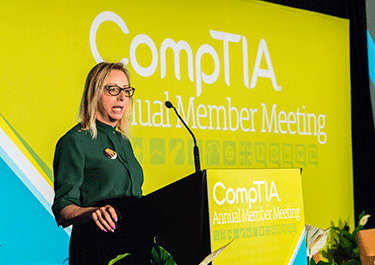.gif?sfvrsn=d0e67b50_0) Not everyone has an Internet of Things-enabled smart home or office these days, but certainly everyone adjacent to the tech world has heard of the concept by now. This year’s CompTIA IT Industry Outlook, which identifies the trends that drive the tech world, provides insight on the two-sided nature of today’s industry and consumer perspective on the IoT.
Not everyone has an Internet of Things-enabled smart home or office these days, but certainly everyone adjacent to the tech world has heard of the concept by now. This year’s CompTIA IT Industry Outlook, which identifies the trends that drive the tech world, provides insight on the two-sided nature of today’s industry and consumer perspective on the IoT.
On one hand, consumer awareness and adoption is up. The last few years have seen major pushes by some of the biggest names in tech to get customers accustomed to home automation. Both Walmart and Amazon have acquired smart locks companies to facilitate next-gen in-home delivery. Best Buy and Amazon have launched home IoT audit and installation services to assess a customer’s needs and set up an applicable suite of devices in their homes. And use cases on the business level have likewise expanded.
Enterprise-Class IoT Needs Enterprise-Class Security
Even as the public conversation over data security and privacy reaches another peak, alarming stories about alarming vulnerabilities in IoT home devices – like baby monitors – continue to appear in the news. And as the use of IoT devices grows in offices, it’s not difficult to see how the concerns might be multiplied.
Businesses are more likely targets for cybercrime than individuals, and more wired devices means even more valuable data for hackers to get their hands on. Managing comprehensive network security is a hard enough task when only computers and mobile devices are concerned. As the Outlook Report puts it, IoT “drastically increases the scope of IT responsibilities.”
So a world in which every business benefits from wired devices will have to be one in which there’s no confusion about how to secure and maintain every device on a network – whether it’s a PC, a tablet or a thermostat. Businesses can’t afford to have IoT be their cybersecurity Achilles’ heel.
Enterprise-Class IoT Needs Enterprise-Class AI
The sheer number of variables at play in a given office or retail environment is beyond what individuals can easily imagine. People use resources in ways they’re not cognizant of; whether it’s gravitating toward a specific conference room at a particular time of day, flocking to a particular part of a store while passing numerous others or entering through one specific door instead of another. Environments have built-in inefficiencies that are too miniscule to notice, but in aggregate can cost businesses big.
IoT is already giving business unprecedented visibility into these inefficiencies and offering ways to fix them. By gathering foot traffic data and other metrics from wired devices, businesses can identify space usage trends that are normally an invisible part of daily life and move things around accordingly to address the problem.
But the amount of data a full suite of IoT solutions collects and aggregates is impossible to make sense of without the right AI to sift through it and point out things that might be meaningful. As IoT’s popularity grows and as the data it generates becomes even bigger, it will be even more critical that businesses use appropriately sophisticated AI solutions to turn raw data into actionable information.
Enterprise-Class IoT Needs an IoT-Specific Job Role
In order to make the most out of a suite of smart devices – and to do it without putting critical data at risk – businesses will increasingly need IT pros with a specific skill-set. These IT pros will need to understand how a suite of IoT devices should be set up to maximize value. They’ll need to know how to keep every device secure. And they’ll need to understand the trend analytics coming out of the AI dashboard – and how to explain and apply them.
In order to start showing up everywhere, the Internet of Things will need to be completely secure and provide demonstrable value, and will need skilled IT pros to install, secure and manage it. And so while wired devices might not look like things that traditionally fall under the purview of the IT department, they’re not all that different.

 Add CompTIA to your favorite RSS reader
Add CompTIA to your favorite RSS reader

